
It’s been three years since the last post, but welcome back to our Toolmanship series! The goal of this series is to teach the very basics of tool use to those men who never got around to learning how to be handy when they were growing up.
In this edition, we turn our attention to wrenches (or spanners for our readers who use British English). They’re an essential tool to have in your toolbox and are used to tighten and loosen nuts, bolts, screws, and pipes. Below we’ll take a look at the most common kinds of wrenches and how to use them.
General Wrench Use Guidelines
Select the right wrench size for the job. To avoid damaging your fastener or yourself, always select a wrench jaw size that corresponds to the fastener you’re tightening or loosening. Also, make sure your wrench’s jaw is in complete contact with the fastener before applying pressure. These two things will go a long way in preventing your wrench from slipping and you swearing about a bruised knuckle.

When using a wrench, it’s best to pull (see left image). If you do need to push, use the heel of your hand. That way if the wrench slips, you won’t bark a knuckle.
Pull, don’t push. When using a wrench, you typically want to position yourself so that you pull it instead of push it. This ensures you don’t bark a knuckle whenever the wrench slips off the fastener. If you do need to push a wrench, use the heel of your hand, that way if the wrench slips, you won’t hurt yourself.
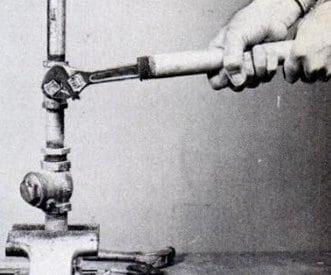
Don’t use a “cheater bar” to gain more leverage. You risk damaging the tool or injuring yourself. If you need more leverage, get a longer wrench.
Don’t add more leverage with pipe. You may have seen your dad put a longer piece of pipe over his wrench to gain more leverage when tightening a fastener. You should avoid using “cheater bars” for several reasons. First, they can damage your wrench by bending the handle or jacking up the head. Second, because of the added torque you get with the extra leverage, you risk rounding your fastener if you don’t have the right wrench head for the job. Finally, there’s a chance the cheater bar will slip off the wrench’s handle while you’re turning, causing harm to you or others. If you need more leverage, use a longer wrench. If you have a particularly stubborn fastener, apply some penetrating oil (like Liquid Wrench) to the thread, wait a few minutes, and then try loosening.
Don’t hit a wrench with a hammer. Unless you have a special “strike face” wrench that’s designed for being hit with an object, don’t take a hammer to your wrench in order to get more power to turn a stubborn fastener. You risk damaging your wrench.
Don’t use a damaged wrench. If the handle is bent or the jaws look wider than they’re supposed to be, don’t use it.
Buy quality wrenches. Good wrenches last longer; cheap wrenches slip more easily. Personally, I’m a Craftsman fan. They’ve got a lifetime warranty on all their hand tools. If a wrench ever bends or breaks, you can take into a Sears or Ace and they’ll replace it for free, no questions asked (some sales associates might give you guff). I don’t have any affiliation with Craftsman whatsoever — it’s just what I use.
Types of Wrenches and How to Use Them
Adjustable Wrench aka “Crescent Wrench”

This should be your first wrench you buy if you’re just starting your tool collection — one big and one small. An adjustable wrench has one fixed jaw and one adjustable jaw which allows you to use it on a wide variety of fastener sizes. The jaws are typically smooth and flat and designed for gripping square and hex nuts. The head of a crescent wrench is usually angled at 22 1/2 degrees to the handle so that the wrench can be flipped over to provide two different gripping positions in tight spaces.
How to Use a Crescent Wrench
While a crescent wrench is designed so that you can apply pressure on both the fixed and movable jaws, ideally the bulk of your work should be done so that pressure is only applied on the stronger, fixed jaw. Too much pressure on the weaker, adjustable jaw can cause the wrench to break and you to bark a knuckle. When placing the wrench on your nut, the adjustable jaw should be located on the side towards which the rotation is to be performed. This puts the pressure on the fixed jaw. Below is a nice little illustration showcasing this method:
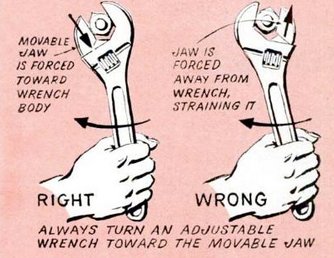
Also, when you place your crescent on a bolt or nut, make sure the adjustable jaw is snugly adjusted to the nut or bolt in order to prevent the wrench from slipping and rounding the nut or bolt.
Open Wrench
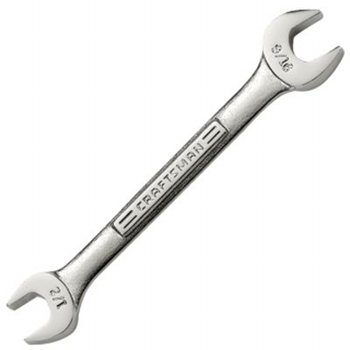
An open wrench is a nonadjustable wrench that comes in a variety of sizes. You usually buy them in sets (in both metric and standard SAE sizes), though you can buy them individually if you want. There are a few advantages that open wrenches offer over adjustable wrenches. First, because both jaws are fixed, you don’t have to worry about breaking an adjustable jaw. Second, they’re really handy to have when you’re tightening and loosening a bunch of nuts and bolts of the same size because you don’t have to readjust anything whenever you put wrench to bolt. Makes tightening and loosening much faster than with an adjustable wrench.
How to Use an Open Wrench
Select the right size open wrench for the nut or bolt you’re loosening or tightening. Reposition the wrench on the fastener after each turn.
Box Wrench

A box wrench has an enclosed opening that looks like a ring. The enclosed opening minimizes the risk of damaging your fastener. This kind of wench is typically used on heavy-duty jobs. Box wrenches usually have a six-point or twelve-point recess and are best used on hex-head fasteners. The twelve-point recess allows you to change the position of the wrench on the nut with only a small handle movement. Some box wrenches have an offset handle which allows for knuckle clearance over obstructions on a flat surface. You’ll also find box wrenches with a ratcheting mechanism which allows for more efficient tightening and loosening.
How to Use a Box Wrench
Not much to it. Select the right size opening for the nut or bolt and start tightening or loosening. Reposition the wrench on the fastener after each turn.
Combination Wrench

You’ll typically find open and box wrenches on the same tool in the form of a combination wrench. One end will be the open-end wrench; the other end is the box wrench. Both ends generally fit the same size nut and bolt.
Socket Wrench

When you’ve got a lot of fastening to do, it’s time to put aside the crescent or open-end wrench and reach for their more efficient brother, the socket wrench. A socket wrench is a hand tool that has a ratcheting mechanism on the head which attaches to various size sockets via a square nub. You can buy sets of sockets that fit every conceivable fastener size (metric and SAE). If you’re just starting your tool collection, buy a socket wrench with a 3/8-inch-square driving mechanism and a socket set with mostly six-point hex sockets — the twelve-point variety can damage nuts and bolts if you apply too much torque.
The biggest benefit of a socket wrench is the ratcheting device. The ratchet device holds in place when you pull in one direction and releases when pulled in the opposite direction. This allows you to quickly tighten a fastener without having to remove and refit the wrench after each and every turn.
The long ratchet handle provides you some nice leverage so you can get plenty of torque to loosen and tighten a bolt or nut. If you need less torque, use a nut driver (see below).
How to Use a Socket Wrench
Make sure to get the right size socket for your fastener. Because a socket wrench provides so much torque, it’s easy to round-off a nut or bolt if it isn’t the right size.
Nut Driver
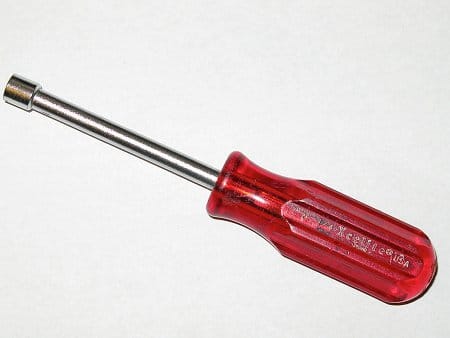
A nut driver looks sort of like a screwdriver, but has a socket wrench on the end. They’re typically used when less torque is needed when tightening or loosening a nut or bolt.
Allen Wrench (aka Hex Key)
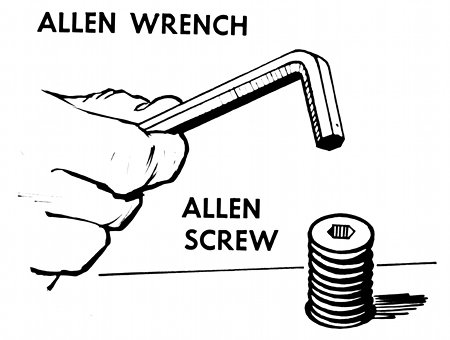
You’ve probably gathered a nice collection of allen wrenches if you’ve bought furniture from IKEA. They’re those small little hockey stick looking things that come with all the hardware for your bookcase. Allen wrenches are used on screws and bolts with a hexagonal socket in the head. You can buy a set of allen wrenches in a variety of sizes to match any job you may encounter. My set of allen wrenches has come in handy more than I thought it would. I’ve used them to change out rollerblade wheels for Kate and on a bunch of projects for Gus.
Pipe Wrench

Pipe wrenches are used to tighten and loosen threaded pipes as well as for killing unsuspecting socialites in a spooky mansion’s conservatory. A pipe wrench is an adjustable wrench — the top jaw moves up or down — and has toothed jaws for gripping onto pipe. The jaws on a pipe wrench are designed so that the top jaw (aka the hook jaw) rocks a little bit in the frame of the wrench. Whenever you apply forward pressure on the handle, the top and bottom jaws come closer together.
Pipe wrenches come in different sizes and are measured by the length of the handle. A 14″ pipe wrench will suffice for most household plumbing work. RIDGID is known for their quality pipe wrenches.
How to Use a Pipe Wrench

Choose the appropriate size wrench for your job. When placing a pipe wrench on the pipe, you want to maintain a small gap between the pipe and the back of the hook jaw. Allowing the back of the hook jaw to come into contact with the pipe reduces the gripping action of the wrench. A one-half-inch gap between the pipe and the back of the hook jaw will do the trick.
Because of its teeth and strong grip, pipe wrenches can leave marks in whatever you’re tightening or loosening, so don’t use a pipe wrench on your nice plumbing fixtures. Save them for when you’re working under the sink. Also, you shouldn’t use a pipe wrench on nuts and bolts. You’ll damage the fastener.
A Wrench Set That Will Cover Pretty Much All Your Needs
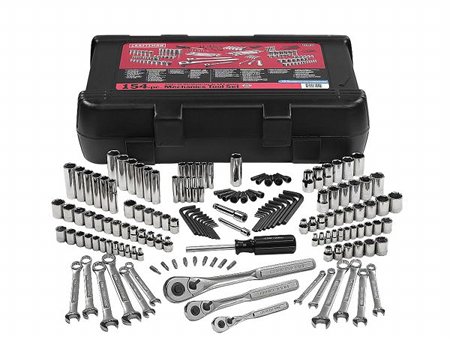
If you’re looking for a wrench set that will cover most of your needs, you can’t go wrong with the Craftsman 154-piece Mechanics Set. My in-laws got me this for Christmas the year we bought our house. It’s a giant, amazing box filled with every conceivable socket you’ll ever need (in both metric and SAE sizes), ratchets in 1/4, 1/2, and 3/8-inch drive sizes, 12 combination wrenches, 21 nut driver bits, and 22 allen wrenches.
This is a great Christmas, groomsman, of housewarming gift for a young man.
Further Reading:
Toolmanship: Screwdriver
Toolmanship: Handsaw
Toolmanship: Hammer


